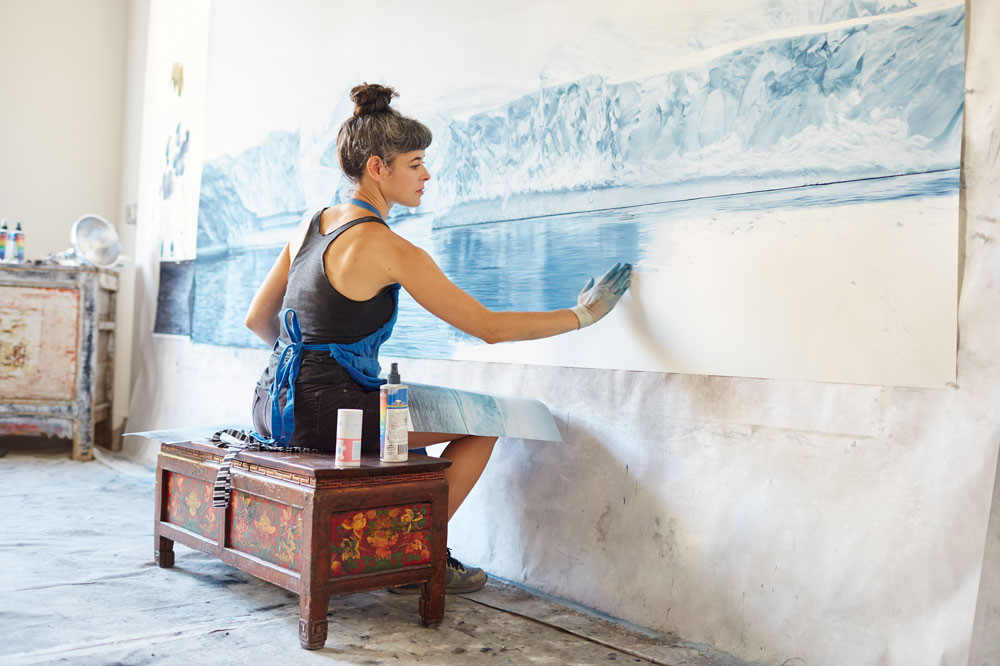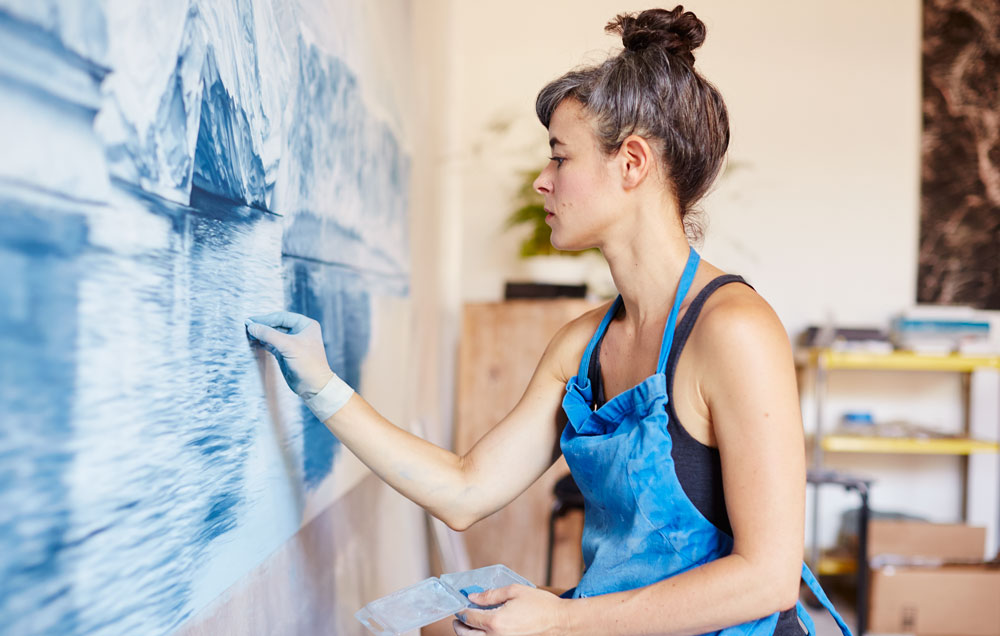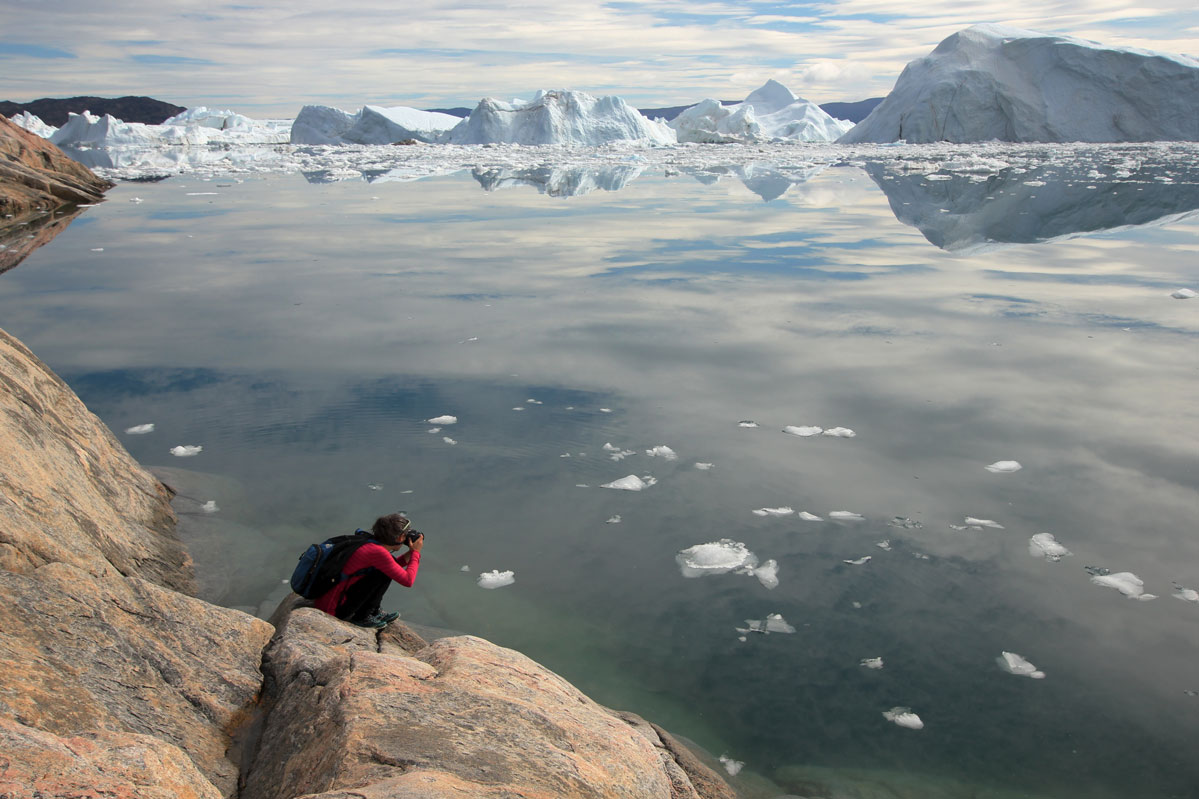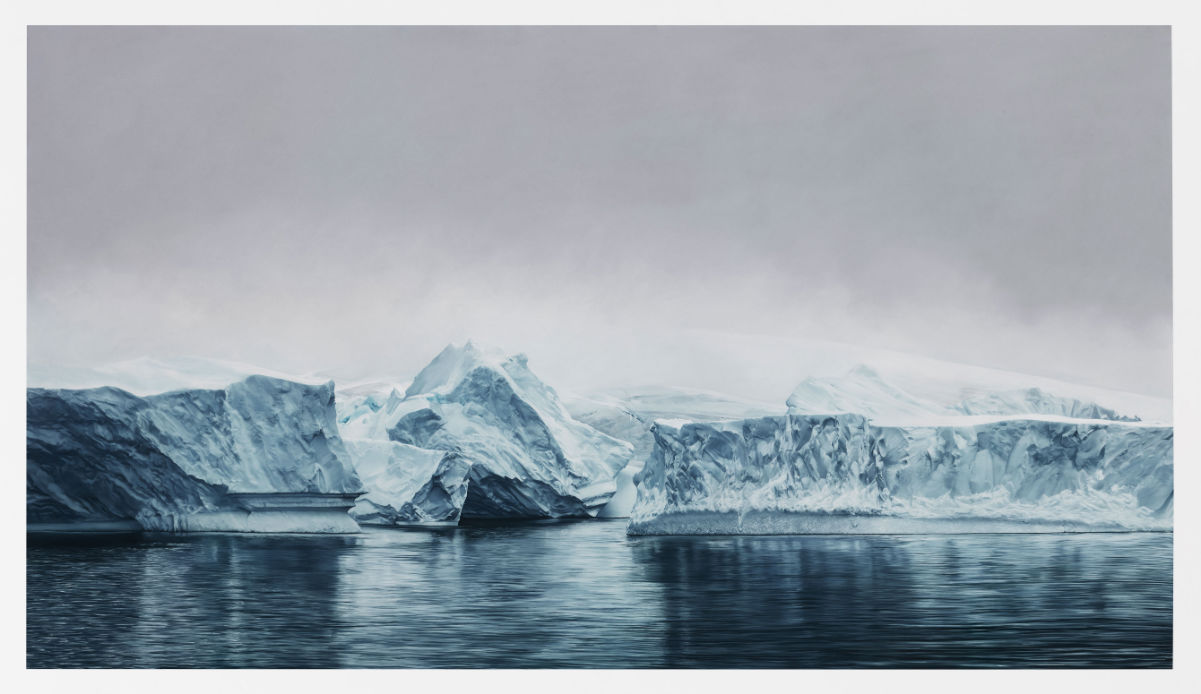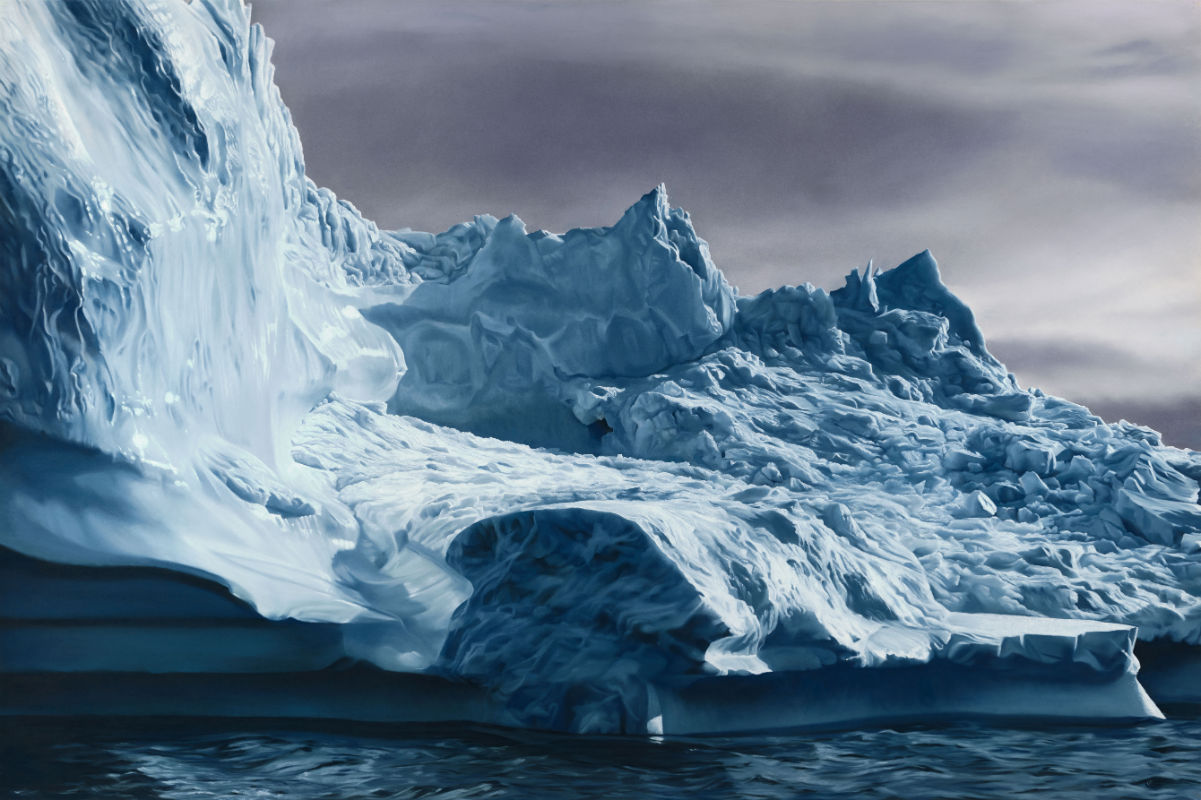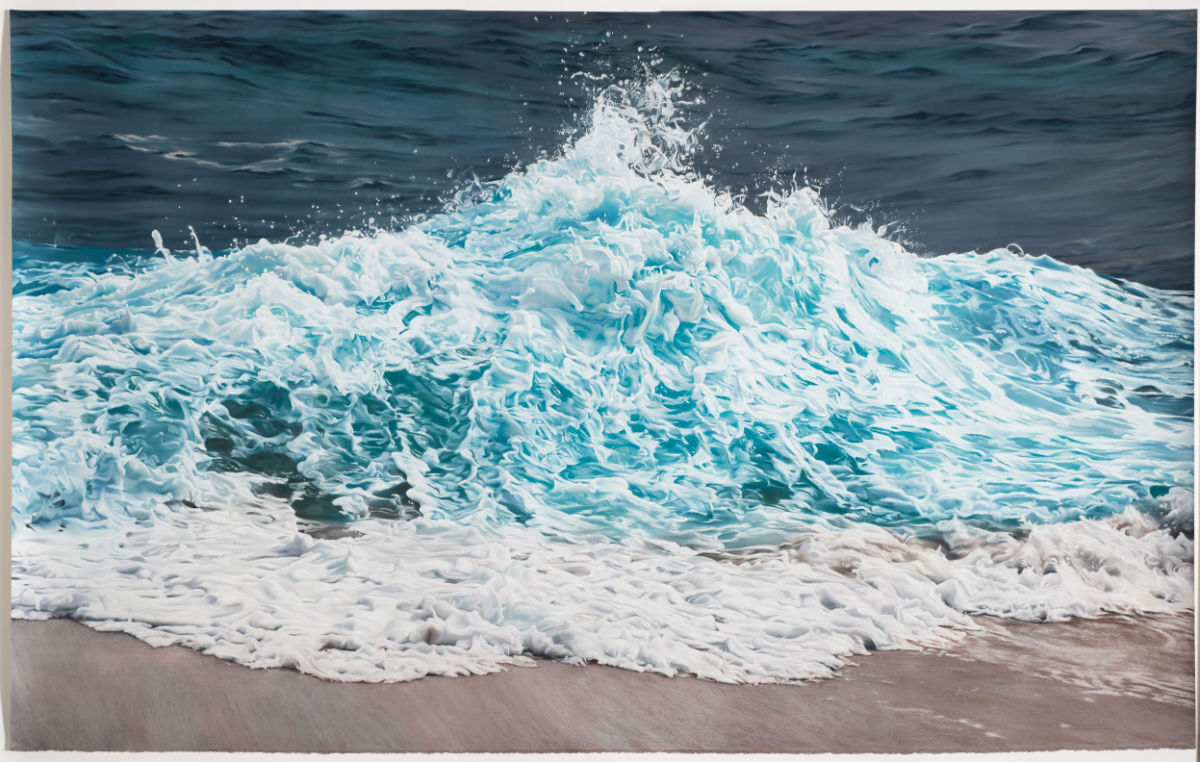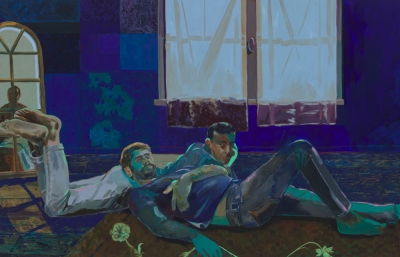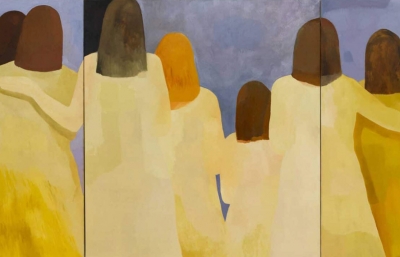Zaria Forman was born and raised in the metropolis of New York City. She grew up alongside her mother, Rena Bass Forman, also an artist, frequenting gallery openings and museum exhibitions. In 2006, fresh out of college, she and her mother made an expedition to the Arctic to photograph the changing landscapes.
During the trip, Zaria made drawings of the horizon and sky but completely avoided ice because she felt technically unprepared to capture its elusive qualities.
Rena Bass Forman was also passionate about environmental issues, her work contemplating the meditative qualities of fleeting light effects on pristine landscapes. She was in the early stages of planning a second trip to Greenland when she fell victim to a brain tumor, and passed away six months later. Before she died, Zaria promised to carry out her mother’s final journey, transforming her mourning into an inspired quest. The following August, she led a group of artists and scholars up the Northwest Coast of Greenland. Titled Chasing the Light, the art expedition mirrored the path that American painter William Bradford made on a steamship called The Panther 143 years ago. Among Zaria’s group was the curator of photography for the New Bedford Whaling Museum in Massachusetts, who was preparing an exhibition of The Panther’s historic voyage. Amidst the melting land of crackling ice and ancient stone peaks, Zaria scattered her mother’s ashes, sealing her immortality in the landscape that inspired her.
Upon returning from the Arctic voyage, Zaria primarily focused on water: ocean waves crashing onto sand, calm ripples in a lake, and sky reflections. She worked from her photos of H2O in its different states. The Far North is a magical world of ten-hour sunsets slightly obscured by heavy mist that clings to the horizon. Zaria’s dedicated studio practice cleared the fog, revealing something more substantial, an urge and responsibility to talk about climate change. Ice could no longer be omitted from her work.
Since I met her in 2013, Zaria has become so busy that she has even stopped teaching yoga. At one point in early 2014, one of her pastel drawings of an iceberg held the number one position on Reddit. The internet phenomenon triggered a tidal wave of press that has only gained in momentum. Her work is making appearances on TV news programs and was even featured on Claire Underwood’s office walls in the HBO drama, House of Cards.
This past October, I got to catch up on Zaria’s latest art adventures. We met up at her solo exhibition at Winston Wachter Gallery on 25th Street in Chelsea. She had recently returned from the Dismaland exhibition outside of London where her work was installed alongside Banksy and Damien Hirst, and she was gearing up for an eventful end of the year. On November 5th and 6th, Zaria presented at TED Talks Live at the Town Hall Theatre in NYC. The following day, she departed on a five-week-long expedition to Antarctica, as an artist-in-residence aboard the National Geographic Explorer. —David Molesky

Photo: Brian Maranan Pineda
David Molesky: How do you go about tackling a beautiful seascape such as the intricate, large-scale pastel titled Maldives no. 13?
Zaria Forman: Maldives no. 13 was inspired by a sunrise I witnessed over a surf break in Male, the capital island of the Maldives. On that particular trip, I woke up at 4:00 a.m. several times to catch the sunrise, as I find a unique quality to the early morning light. I cropped the original photo significantly, focusing on a distant, frothy wave. In all of my drawings, I choose to convey the beauty, as opposed to the devastation of these threatened places. By drawing the viewer in, close to the glowing and tumultuous waves, I attempt to portray the conflicting sense of majesty and peril.
I do my best to depict the scenes I have experienced as honestly as possible, exactly as I remember them, down to every last color and shape. I hope all of this offers the viewer a chance to emotionally connect with a landscape they may never have the chance to visit. If you can experience the sublimity of these landscapes, perhaps you'll be inspired to protect and preserve them.
Studies have shown that art can impact a viewer’s emotions more effectively than a scary news report. Behavioral science tells us that humans take action and make decisions based on emotions above all else. This is why I have dedicated my career to translating and illuminating scientists’ warnings and statistics into an accessible medium, one that people can connect with, on a level that might penetrate more deeply than scientific facts.

Photo: Brian Maranan Pineda
Tell me about the palette of colors and dry pastel material you used here.
I have been using Unison Colour Soft Pastels exclusively for over ten years now. I was introduced to them in college, and have continued to love their rich colors and soft feel. I developed a relationship with the company in the last two years, after reaching out to see if they might be interested in sponsoring some of my materials. Their pastels are handmade in Northern England, and they have been absolutely lovely to work with. When I started working on Maldives no. 13, I struggled to find the right color for the froth in the wave. I mixed several colors on the paper and still couldn't get it just right. I asked the Unison team if they might be up for the challenge, and thus, began a collaboration that continues today. I explain to them what I am looking for, they make some samples, and eventually we perfect it together. After several new colors were created, they decided to put together a new set titled "Ocean Blues inspired by Zaria Forman," and a few free sets were given away to fans of mine.
What kinds of reference materials do you use to guide your process?
My process begins with visiting the places at the forefront of climate change. I take thousands of photographs on site. Back in the studio, I work from both my memory of the experience and the photographs to create large-scale compositions, sometimes over ten feet wide. Ninety percent of the time, I work from my own photographs, but occasionally I will use my mother's, from our first trip to Greenland together. I am immensely grateful for all of the negatives and contact sheets she left behind, as they allow me a chance to collaborate with her, even after her passing.
This past year, I have also referenced a few of my friend Todd Murphy's photographs. He has been to the Arctic and Antarctica several times, and has generously allowed me to peruse all of his photos, pick and choose, and edit as I wish. I consider the two drawings I have made from his photos of Antarctica as preliminary studies for my upcoming expedition there. It is generally important for me to physically experience the landscape I draw, but every now and then I make exceptions.

Photo: Brian Maranan Pineda
How did it come about that you were included in Dismaland? What was your take on the experience?
Banksy contacted me in early June to invite me to participate. It was an enormous honor to be a part of such an exciting spectacle. I thoroughly enjoyed the exhibit and felt it was meticulously and very well curated. It was wonderful to meet some of the other participating artists, who were all equally thrilled and honored to be there, no matter how well-known they were. Banksy was a joy to communicate with, and his crew in Weston Super-mare was not only hard-working and diligent, but also very kind and accommodating, even during the most stressful last hours of hanging the show and prepping it for opening day. The entire experience feels like a dream to me now; certainly one I will never forget!
How do you hope your art will influence the global conversation about climate change? Do you consider your work to be politically charged?
One of the many gifts my mother gave me was the ability to focus on the positive, rather than dwell in the negative. I hope my drawings can serve as records of landscapes in flux, honoring the transition, and inspiring our global community to take action for the future.
I don't like to label myself as a political or environmental artist, but my work obviously addresses a crisis that requires major changes in government policy.
----
Read the full interview in the January, 2016 issue of Juxtapoz Magazine, available here.
Follow Zaria's adventures in Antarctica on her Instagram.

